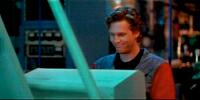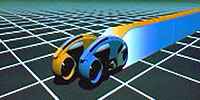Tron
1. Look at how amazing these four types of visual representation are: each one of them shows a different balance between physical and virtual presence. In each, the colors, lines and lighting contribute to specifc relationships between the "natural" and the "virtual" world, and what types of bodies can exist where. 2. In Tron we see how this computer system works in completely personalized and animated ways. Programs are represented as extensions of their users, they acquire a face and a body, and they act in very human-like ways. How does this representation relate to other embodied computer entities we have seen in this class? What types of physical presence do the different components of the system have?
3. One of the summaries from the Internet Movie Database describes Tron as a "unique gladiator movie." Indeed, what takes place inside the computer is much more related to fun and games, and especially videogames, than to work, process, or even computing. How is this representation related to other films we have seen in the class? How are technology, digital technology, computer technology and computer applications reorganized into a game?
4. To follow up on that issue, the film seems to question what computers are for, and representing the inside processes in terms of a game does not actually clarify this. At some point Dr. Walter Gibbs, the inventor of the program, and Dillinger, the Senior Executive argue about this very thing:
5. If you are interested in the design and historical background of the making of Tron, have a look at this 1999 interview with the director, Steven Lisberger. He brings together information about IBM and the state of computer technology at the time, the early stages of computer animation, and how Tron, Blade Runner and The Matrix represent versions of cyberspace.
Check out the Sciflicks webpage on Tron, where you can get images, short clips and more information about the film.
Tron was nominated for two Academy Awards in 1983: Best Costume design, and Best Sound. That was the year of E.T. The Extra-Terrestrial and of Ghandi: Ghandi won for Best Costume Design, and E.T. won for Best Sound. Ghandi also won the Oscar for Best Art Direction-Set Decoration, for which Blade Runner was also a nominee.
All the live action that occurred inside the computer was filmed in black and white, and colorized later with photographic and rotoscopic techniques.
Flynn's program is named "Clu". CLU is an old programming language.
After Flynn escapes from the light cycles arena, it is possible to hear a "Pac-Man" video game and see a graphic on the map he is watching.
The original plan was to have the circuit lines of the "good" programs glow yellow, and the "bad" programs would have blue circuit lines. At one point this was changed to where good programs are blue, and evil ones are red. Some of the original coloring remains, mostly in tank programs (Clu has yellow lines on his uniform, and all of Sark's tank commanders are blue).
Here is an interesting thought from the Internet Movie Database: one of their users points out that the "Bit" actually isn't binary in the film. It has three states: dormant, yes and no.
In these four images we see a combination of embodied presence and disembodied presence. What else do you notice in their different representations of bodies, people and faces? What metaphors are used to present us with this vision?
Gibbs: User requests are what computers are for!
What is the difference? Are users independent of the corporation? We certainly don't see any hackers working at home, or logging into the network from the outside... Even Flynn has to be physically present in the Encom building in order to get in the system. How do you understand this debate? What do you think is at stake in deciding what computers are for?
Dillinger: DOING OUR BUSINESS is what computers are for.
Cast Information
Kevin Flynn/Clu: Jeff Bridges
Alan Bradley/Tron: Bruce Boxleitner
Ed Dillinger/Sark/Master Control Program (voice): David Warner
Lora/Yori: Cindy Morgan
Dr. Walter Gibbs/Dumont: Barnard Hughes
Ram: Dan Shor
Crom: Peter Jurasik
Peter/Sark's Lieutenant: Tony Stephano
Warrior #1: Craig Chudy
Warrior #2: Vince Deadrick Jr.
Expert Disc Warrior: Sam Schatz
Head Guard: Jackson Bostwick
Factory Guard: David S. Cass Sr.
Contact the instructor: dk2244@yahoo.com



